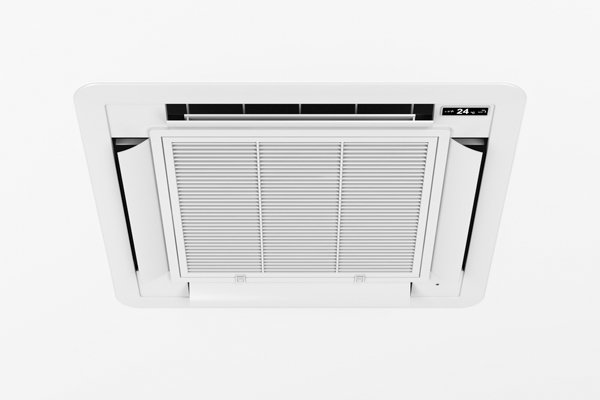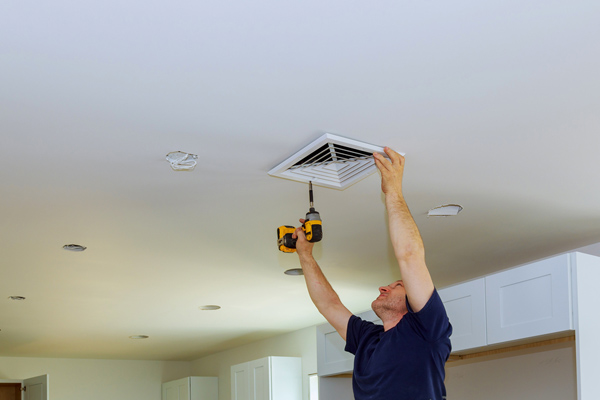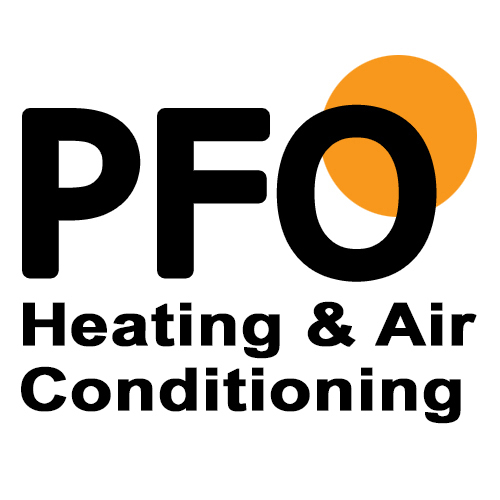
There is a wide range of air conditioning systems available in the market. Among them are window air conditioners, central HVAC systems, and ductless units. However, if you want to maintain the aesthetics of your home, and you wish to install a system that out of sight, then consider a ceiling cassette ductless unit.
What Is A Ceiling Cassette?
Contents
A ceiling cassette is a type of ductless system whose indoor air handler is installed above the ceiling. Therefore, it is hidden from view. The only thing that is visible with this type of ductless indoor air handler is its discharge grille. All the other components are placed above the ceiling. Because of its design, this system can be installed in any room and blend well with its surroundings.
Conditioned air is distributed through the vents located on the sides of the unit. The unit’s compressor or the outdoor unit is installed outside the building similar to how a conventional mini-split unit. When compared to a wall-mounted ductless system, the ceiling cassette is more powerful. Because of its powerful performance, most people prefer to install the ceiling cassette in commercial or office buildings.
Features Of A Ceiling Cassette
Ceiling cassette air conditioning units are designed with many features. We are going to highlight some of them below:
Quiet Design
This unit is designed with a fan that is large in diameter. Because of the large size of the fan, the system is able to push a greater volume of airflow at a slow speed. This feature brings the noise level down. The noise levels of a ceiling cassette can be as low as 38dBA. This is only slightly higher than a whisper.
Comfort Control
There are return air sensors in the indoor air handlers of ceiling cassettes. The work of these sensors is to monitor the room conditions so that the settings can be adjusted by the ductless unit. Because of this, your temperature preferences are maintained at a consistent level at all times. Apart from that, the vents of the indoor unit are adjustable. This allows the system to direct the conditioned air where it is needed the most.

Improved Indoor Air Quality
The air filters in most ceiling cassette models are easy-to-clean and accessible. This is to allow for easy removal, cleaning, and reinsertion of the filters. This ensures that you never have to depend on an unit with dirty filters. After cleaning them, you can relax in your house knowing that your unit’s filters are in good condition and are effectively doing the task of trapping pollutants and contaminants. This is an excellent means to improve your indoor air quality.
Preventing pollutants and contaminants from entering your home is not the only benefit of cleaning the filters of this system. Because you are able to clean them regularly, you will be able to save money that you could have used to replace filters that have been obstructed by too much dirt, dust, and debris.
Another advantage of a ceiling cassette is it can bring in fresh outdoor air. The unit is designed to draw in and cycle fresh air throughout your house, which is different from other A/Cs that repeatedly recycle the same air in your home. With this feature, you won’t have to worry about poor quality indoor air.
A ceiling cassette air conditioner can also purify air. However, you have to install photocatalytic purification filters for it to be able to do so. These filters are designed to eliminate harmful contaminants and other air pollutants from your home when installed in the unit.
Remote Operation
Another benefit of installing a ceiling cassette is it allows for remote operation. Among its range of control options are those that allow you to customize your system and control the temperature remotely. You can customize the system based on your thermal preference and other requirements that are specific to your needs.
Some models of this unit are designed with smart controllers. These controllers allow you the comfort of controlling the system via your smartphone or tablet. With this controller, managing your system is easy even when you are not home. You can now rest easy knowing that you won’t return to a sweltering or frigid home after a long day at work.
Other Features
When compared to wall-mounted air conditioners, ceiling cassettes do not have as many features as the other unit. However, this system is designed with several features that can serve various applications. Most of these features depend on the make and model of the unit you install. We recommend that before installing a unit, you ensure it has the features you are looking for so that it can serve you well. Below are some of these features:
- They are compact and lightweight.
- Have the ability to release conditioned air in four directions.
- They come in different designs so you can choose one that matches the interior of your home.
- They are ozone and environmentally-friendly thanks to the fact that they use R410A refrigerant
The Pros And Cons Of A Ceiling Cassette
Pros
- Among the benefits of installing a ceiling cassette air conditioning system is it can distribute conditioned air well throughout the room. Its large and powerful fans allow for the circulation of conditioned air in larger spaces as compared to other air conditioners.
- This system’s cooling capabilities are powerful. For instance, if you installed the unit in a large family room and you now want the rooms adjacent to it conditioned, you won’t need to add another A/C. All you’ll have to do is install a branch duct. This duct will direct some of the conditioned air into the other rooms, making it possible for you to cool both rooms without the need for an extra unit.
- Another advantage of this unit is it allows you to maximize the wall and floor space. This is because the indoor air handler is installed in the ceiling. This also allows it to maintain a low profile.
- Another advantage of installing a ceiling cassette is you will save on energy costs. This unit is designed with a programmable thermostat and variable speed fans that allow it to consume less energy. This means that this system can make the necessary adjustments, depending on the surroundings so as to give you a temperature that is consistent, therefore, saving energy.
Disadvantages
- Installation of the ceiling cassette AC unit can be costly and time-consuming, especially if you are installing it in a large building. The compressor of this unit is mounted outdoors. A conduit unit is used to connect it to the indoor unit. Because of the size of the building, the conduit line might be long, something that will add up to the expenses. Also, during the installation of the conduit, many holes will be drilled into the wall, therefore, consuming more time.
- Small spaces are not ideal for ceiling cassettes especially if the space in the ceiling is limited. For this unit to work properly, you need to have enough space in the ceiling. For small spaces, you have to install other types of air conditioners.
Choosing A Ceiling Cassette System
Most of the indoor unit of the ceiling cassette are hidden behind the ceiling. Only the grill is visible by one inch. Therefore, if you are looking for an HVAC system with improved coverage and that can be concealed, consider installing the ceiling cassette.
Even though this system has been designed for use in office or commercial spaces, you can install the mini-split in a big room in residential applications.
When it not possible to install a wall-mounted split system or any other type of air conditioner, an excellent choice for you is a ceiling cassette.

Ceiling Cassette Unit Installation
Make sure that the unit will fit into the selected space even before you start the installation process. A ceiling cassette usually measures around 24 by 24 inches. Most houses are built with rafters that have a clearance of 16 inches. If this is the case in your home. Then you have to customize the space in order to install a ceiling cassette unit.
A huge part of this air conditioning system is placed above the ceiling. For it not to place its weight on the ceiling and damage it, the unit must be hang by rods or cables from the edifice above it. For this reason, there needs to be space that measures at least 10 to 20 inches above the ceiling for the bulk of the indoor unit to fit.
The indoor unit of the ceiling cassette is usually installed at the center of the ceiling. This is because the system is at its best when all of its four vents are positioned in a way that they can distribute conditioned air evenly around the room. However, this doesn’t mean that you cannot install it in another location. If, for instance, you choose a corner as the point of installation, make sure you close all the other vents that are blocked by the walls.
Conclusion
Before choosing a ductless unit for your home, we recommend that you consult a professional HVAC contractor. This is to ensure that you install a unit that properly fits the available space and that can meet your home heating and cooling requirements.
Check Out One Of Our Ductless Installation Projects
Mitsubishi Ductless Installation Project In Rocky Hill, New Jersey
Call PFO Heating & Air Conditioning For More Information About Ductless HVAC Systems

For all your HVAC system needs, call PFO Heating & Air Conditioning today. Our technicians are all NATE-certified, and they have a great deal of experience. They’ll also determine what your home comfort needs are and determine the best and most affordable solutions to meet them.
As a full-service HVAC company, PFO Heating & Air Conditioning offers an array of HVAC services. This includes heating and cooling installations, tuneups, repairs, and much more. We offer free, in-home consultations. Call now to schedule an appointment.
Click here to contact us now or call us at (800) 253-9001 to find out more!



